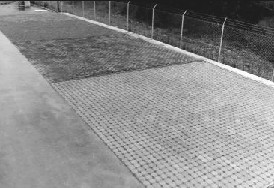

| Case Studies | ||
| Olympia
Washington: Office Parking Lot (www.ecy.wa.gov.programs/wq/stormwater/index.html) Study conducted by Center for Urban Water Resources Management, University of Washington. Adjacent parking stalls were constructed using four different approaches to permeable paving. These systems consisted of a combination of grass and gravel. |
||
| The different
approaches included: 1. Network of plastic cells filled with grass 2. Network of plastic cells filled with gravel 3. System of impervious blocks separated by grass area (60% impervious) 4. System of impervious blocks separated by gravel area (90% impervious) |
||
| An adjacent stall constructed out of traditional asphalt was used as a control medium | ||
 |
||
|
Permeable Paving Approaches in Olympia Parking Lot |
||
| Results of the study show the following
relationships (Taken from: EPA-841-B-00-005B): - The use of permeable pavement systems dramatically reduced surface runoff volume and attenuated the peak discharge. - Although there were significant structural differences between the systems, the hydrologic benefits were consistent. - Storm characteristics and weather conditions influenced the hydrologic responses of the systems. -- Permeable pavement system types vary widely in cost and are more expensive than typical asphalt pavements. Cost comparisons between permeable pavement installations and conventional ponds or underground vaults are limited. However, the elimination of conventional systems and reduced life cycle and maintenance costs can result in significant cost savings over the long term. - A significant contribution of permeable pavements is the ability to reduce effective impervious area, which has a direct connection with downstream drainage systems. This strategy of hydrologic and hydraulic disconnectivity can be used to control runoff timing, reduce runoff volume, and provide water quality benefits. |
||